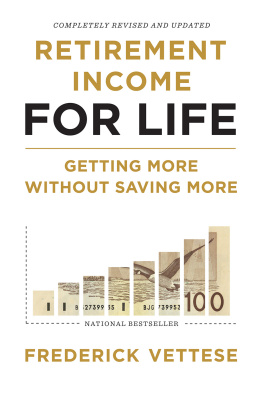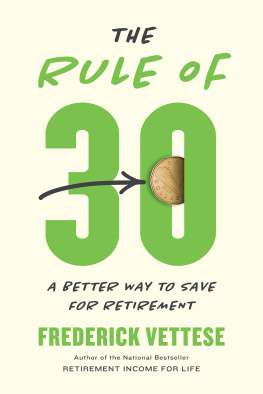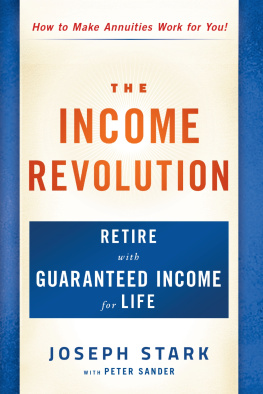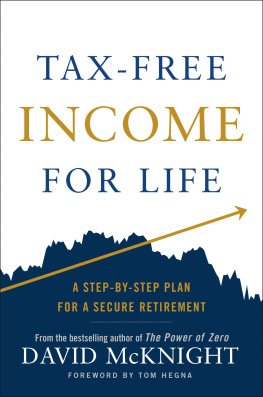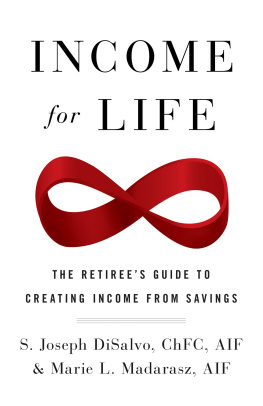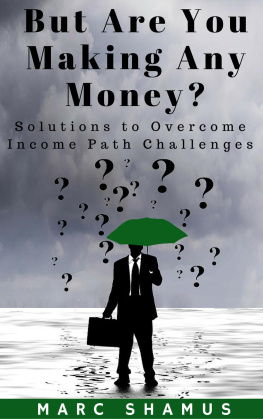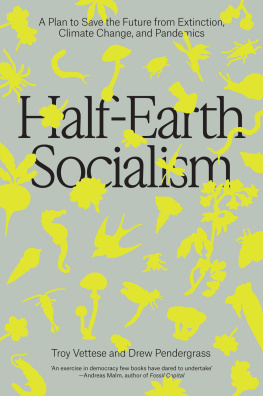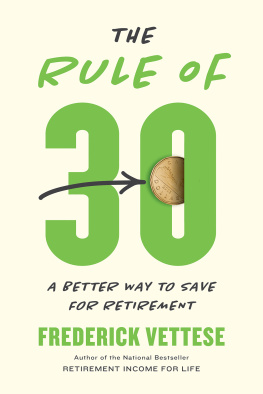Frederick Vettese - Retirement Income for Life
Here you can read online Frederick Vettese - Retirement Income for Life full text of the book (entire story) in english for free. Download pdf and epub, get meaning, cover and reviews about this ebook. year: 2020, publisher: ECW Press, genre: Romance novel. Description of the work, (preface) as well as reviews are available. Best literature library LitArk.com created for fans of good reading and offers a wide selection of genres:
Romance novel
Science fiction
Adventure
Detective
Science
History
Home and family
Prose
Art
Politics
Computer
Non-fiction
Religion
Business
Children
Humor
Choose a favorite category and find really read worthwhile books. Enjoy immersion in the world of imagination, feel the emotions of the characters or learn something new for yourself, make an fascinating discovery.
- Book:Retirement Income for Life
- Author:
- Publisher:ECW Press
- Genre:
- Year:2020
- Rating:3 / 5
- Favourites:Add to favourites
- Your mark:
- 60
- 1
- 2
- 3
- 4
- 5
Retirement Income for Life: summary, description and annotation
We offer to read an annotation, description, summary or preface (depends on what the author of the book "Retirement Income for Life" wrote himself). If you haven't found the necessary information about the book — write in the comments, we will try to find it.
Retirement Income for Life — read online for free the complete book (whole text) full work
Below is the text of the book, divided by pages. System saving the place of the last page read, allows you to conveniently read the book "Retirement Income for Life" online for free, without having to search again every time where you left off. Put a bookmark, and you can go to the page where you finished reading at any time.
Font size:
Interval:
Bookmark:
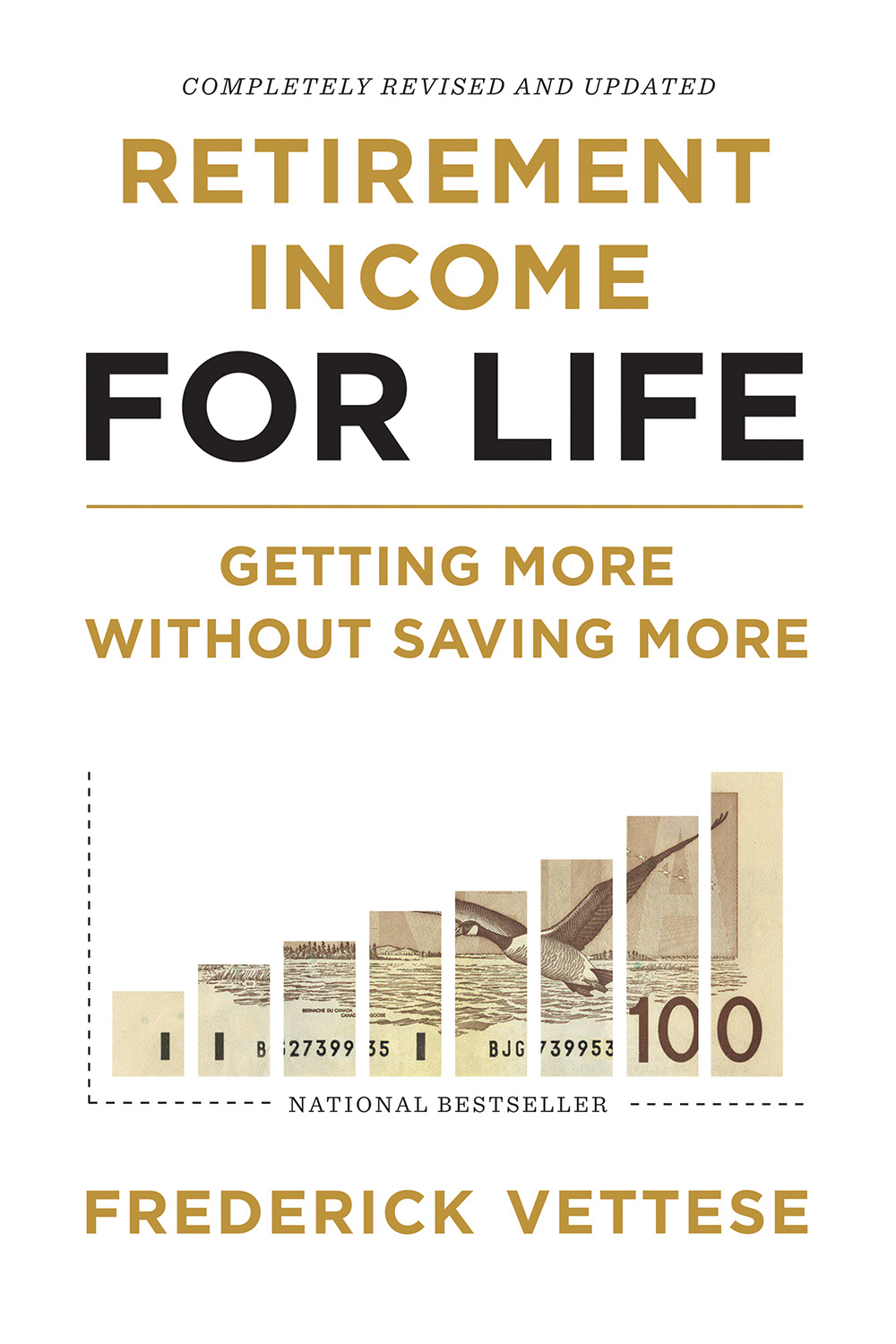
Retirement Income for Life
Getting More without Saving More
Frederick Vettese

To my father, Mario, whose legacy will live on for decades to come.
Decades ago, a mentor taught me that the urge to edit is stronger than the sex drive. It helps to explain why I felt the need to revise Retirement Income for Life a mere two years after its initial release.
In fact, there were many valid reasons to embark on this revision. First, it was necessary to address what turned out to be the most common situation: readers who were still a few years away from retirement wanted to know how they could improve their financial situation in the time they had left. This scenario wasnt explicitly covered in the original book.
Second, I felt inclined to reorganize the chapters into a more logical sequence. We actuaries are nothing if not logical. I also added chapters to address special situations, such as high-net-worth couples, early retirees, single retirees, and early death.
Finally, it was important to reflect some significant developments since the release of the first book. These include the impact of the expanded Canada Pension Plan and the possible introduction of deferred annuities that start at age 85. The biggest development, however, appears to be the fallout from the COVID-19 pandemic. I say appears to be since it was still in its early stages as I was completing the manuscript.
In spite of the changes, the five enhancements, which made up the core of the original book, are still intact, although not without some refinements. Ultimately, this new edition is not just a revision; it is more of a reboot, one that I hope will continue to help readers.
Frederick Vettese, April 2020
My first lesson in spending came at the age of four, when I frequently took money out of my mothers purse to buy candy at the local convenience store. (How I got to the store on my own is another story.) Sometimes it would be just a nickel or a dime, but I wouldnt hesitate to grab a five-dollar bill if there was no loose change.
I didnt get away with it, though. My mother or father would get a call from the store saying that little Freddie had come in to buy a five-cent chocolate bar. They would tell the store owner to give me what I wanted and send me home.
My older brother, who was all of six at the time, cautioned that if I kept up my profligate ways, the family would run out of money. There is no evidence that I heeded his warning, which frankly sounded a little alarmist to me even then. Nevertheless, my parents eventually made their money less accessible, which put an end to my shopping expeditions.
I learned two things from this experience: First, it is easier to spend someone elses money than ones own, a privilege I have rarely been able to repeat since age four. Second, I needed a better strategy if I wanted my spending to be sustainable. This book offers such a strategy, though it is geared more for retirees than for four-year-olds.
Drawing down ones savings in retirement is something very few retirees do well, even with the help of professional advisors. Some retirees outlive their money. An even greater number systematically underspend for fear of outliving their money. And many retirees from both camps waste a substantial part of their wealth by employing inefficient drawdown strategies or spending more than necessary on investment fees.
There are several reasons for this sorry state of affairs. First, drawing an income from ones savings was not a mainstream issue until recently. Most of the retirement planning literature to date has focused on the task of accumulating money rather than decumulating it. Even the latest robo-advisors, which automate investing (more on this in Chapter 27), seem to be more focused on helping people build their nest eggs, not spend them. With over one thousand Canadians turning 65 every day, however, the cultivation of good decumulation practices has become an urgent matter.
Second, it seems nobody wants to see retirees drawing down their savings certainly not the financial advisor who takes a percentage of their assets each year. Nor do retirees children, who might fear that they will (a) receive no inheritance or (b) have to support their aged parents in their later years. As for the person who is most aggrieved at seeing wealth diminish well, its the retiree. A declining account balance makes one feel financially vulnerable and this becomes an ongoing source of existentialist angst. As I note in Chapter 12, drawing down ones assets in retirement is a stark reminder not only of our dwindling influence in this life but also of our own mortality.
If you have significant savings, I have no doubt that the strategies described here will put you in a stronger position to cope with another financial meltdown such as the one we experienced in 2008, or the one that may be unfolding in 2020. Even if the capital markets behave themselves in the years to come and lets all hope they do you can still look forward to more income with less anxiety.
Identifying the Decumulation Problem
Part I shows that turning a nest egg into a regular stream of income is more difficult than it looks, even when you follow a well-accepted decumulation strategy. A retiring couple called the Thompsons do everything by the book and still run out of money. I take them through some basic adjustments to their strategy to get them ready for the enhancements in Part II.
Who Should Read This Book?
Most retirement books focus on the accumulation phase, meaning that they help you to decide how much to save and how to invest as you build your nest egg. In this book, I assume that the readers accumulation phase is over or nearly over. Rather than salting away more money for retirement, your primary concern is to turn the savings you already have into a steady income stream that will last for the rest of your life.
I am assuming that you have already accumulated significant savings, meaning at least a six-figure amount. For the most part, this money will be held in tax-sheltered vehicles like RRSPs, TFSAs, and defined contribution(DC) pension plans, but some of it could also be stashed away in investment properties, equity in a small business, and bank accounts and stocks that you might be holding outside of any tax-sheltered vehicle.
RRSP stands for Registered Retirement Savings Plan. Contributions made to an RRSP are tax-deductible, and investment income earned is tax-deferred. Income tax is payable only if an amount is withdrawn from an RRSP and taken into income.
Unlike an RRSP, contributions to a Tax-Free Savings Account (TFSA) are not tax-deductible. They are nevertheless attractive because the investment income as well as any withdrawals are never subject to income tax.
A defined contribution (DC) pension plan is a plan you access through your workplace in which money is put aside for retirement. Contributions are usually made by the employees (you) by payroll deduction and the employer makes matching contributions. The money in a DC Pension Plan earns tax-deferred investment income during the accumulation phase.
While you might have earned some pension benefits in a defined benefit (DB) pension plan, Im assuming that is not the main source of your retirement income. If it were, you wouldnt really need this book.
Font size:
Interval:
Bookmark:
Similar books «Retirement Income for Life»
Look at similar books to Retirement Income for Life. We have selected literature similar in name and meaning in the hope of providing readers with more options to find new, interesting, not yet read works.
Discussion, reviews of the book Retirement Income for Life and just readers' own opinions. Leave your comments, write what you think about the work, its meaning or the main characters. Specify what exactly you liked and what you didn't like, and why you think so.

